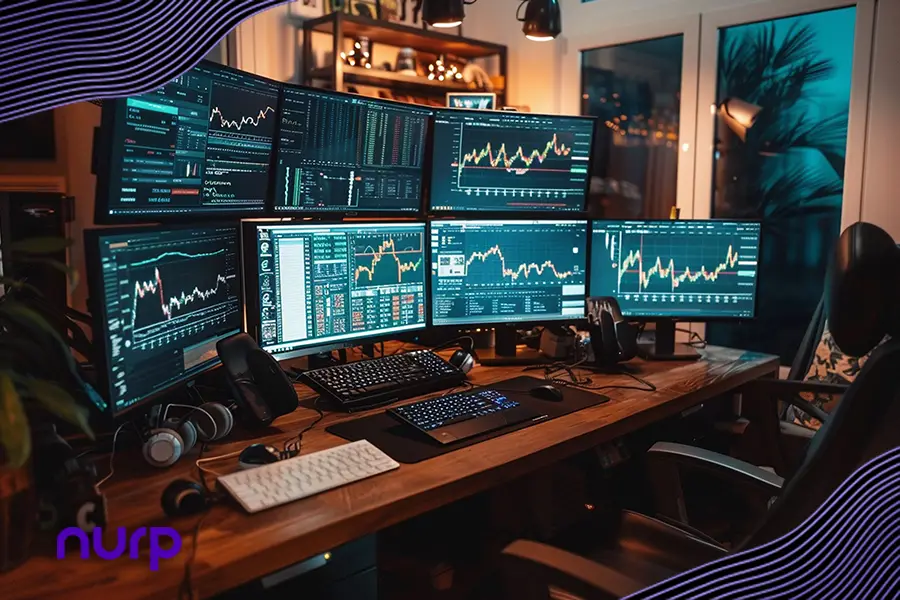Key Takeaways
Define your needs and choose a trading algorithm based on your specific trading style, market focus, and risk tolerance.
Prioritize algorithms with clear strategies, proven performance data, and customization options.
Remember that trading is risky, so never invest more than you can afford to lose, and carefully evaluate all options before committing.
Introduction
Trading algorithms, often referred to as “algos,” are no longer exclusives tools used only by the elite on Wall Street. Today, these powerful trading systems have become widely accessible, offering individual traders and small institutions the opportunity to harness their potential. But with so many options, how do you choose the right one? It’s not a one-size-fits-all decision, and finding the best fit requires careful consideration of various factors. This guide will help you navigate the complexities involved in selecting the best trading algorithm for your needs. Before we proceed, a vital reminder that trading is inherently risky and one should never trade with money they cannot afford to lose.
Read More: Quantitative Trading Myths Busted The Facts Will Shock You!
Understanding Trading Algorithms Software
First things first: what exactly is a trading algorithm? In the simplest terms, a trading algorithm is a set of rules coded into a software program that automatically executes trades when specific market conditions are met. These conditions can be based on price, volume, or other technical indicators. The goal? To remove human emotions from trading and execute strategies with speed and precision.
But not all algorithms are created equal. Some are simple, while others are highly complex. Some focus on short-term gains, while others are designed for long-term investments. Knowing what you’re looking for is key to making the right choice.
What Do You Want From a Trading Algorithm?
Before diving into the marketplace, it’s essential to clearly define what you want from a trading algorithm. This involves more than just picking one that looks good on paper; it means identifying your specific needs and goals. To do this, you’ll need to ask yourself a few critical questions.
What’s Your Trading Style?
Are you a day trader, swing trader, or long-term investor? Different algorithms cater to different styles. Day traders might need an algorithm that can execute high-frequency trades quickly, while long-term investors might prefer one that identifies and capitalizes on broader market trends.
What Markets Are You Trading?
Forex, stocks, commodities, and cryptocurrencies all have their own market dynamics. Make sure the algorithm you’re considering is designed for the specific markets you trade.
What’s Your Risk Tolerance?
No algorithm is risk-free, and you need to be honest about your comfort level with potential losses. Some algorithms are aggressive, chasing higher returns but with greater risk, while others take a more conservative approach.
By answering these questions, you’ll narrow down your options and focus on algorithms that align with your trading goals. This focused approach helps ensure that you invest in a tool that not only fits your strategy but also enhances your chances of achieving consistent and favorable trading outcomes.
Key Features to Look for in a Trading Algorithm
Once you know what you’re after, it’s time to dig into the specifics. Here are the key features you should look for when evaluating trading algorithms for sale:
Strategy Transparency
Does the algorithm provider clearly explain the strategy behind the algo? You should understand the logic and assumptions driving the algorithm’s decisions. If the strategy is too vague or overly complex, it might be a red flag.
Backtesting Results
Reputable algorithm providers should have backtesting data to support their claims. Backtesting involves running the algorithm against historical data to see how it would have performed. Look for detailed reports showing performance metrics like return on investment (ROI), drawdowns, and win/loss ratios over various market conditions.
Live Performance Data
Backtesting is important, but it’s not enough. Make sure you check live performance data as well. How has the algorithm performed in real-time trading? This data is crucial because it reflects how the algorithm deals with current market conditions, which can differ from historical patterns.
Customization Options
Not all traders are the same, and you might need to tweak an algorithm to better fit your strategy. Look for algorithms that allow some level of customization, whether it’s adjusting risk parameters, trading frequencies, or market conditions.
Risk Management Tools
A good algorithm should come with built-in risk management features, like stop-loss orders, trailing stops, or position-sizing options. These tools can help protect your capital when the market goes against you.
Ease of Use
You shouldn’t need a Ph.D. in computer science to operate your trading algorithm. Look for user-friendly interfaces, clear instructions, and good customer support. If you have to spend too much time figuring out how to use the algorithm, it’s probably not worth your investment.
Provider Reputation
Do your due diligence on the algorithm provider. Look for reviews, testimonials, and even complaints online. Reputable providers will have a track record you can verify. Beware of companies that promise guaranteed returns or seem too good to be true.
Costs and Fees
Trading algorithms come with various costs, from upfront purchase fees to ongoing subscription costs or commissions on trades. Be clear about what you’re paying for and how these costs might impact your overall profitability.
Red Flags to Watch Out For
While there are many legitimate trading algorithms on the market, the industry isn’t free from scams or poorly designed products. Here are some red flags to be aware of:
Guaranteed Returns: No algorithm can guarantee profits. If a provider makes such claims, it’s best to walk away.
Lack of Transparency: If the provider is unwilling to share backtesting data, live performance records, or detailed information about the strategy, consider it a warning sign.
Unrealistic Profit Claims: Be skeptical of algorithms that promise consistently high returns with little to no risk. If it sounds too good to be true, it probably is.
Try Before You Buy (Or Get Your Money Back)
One of the best ways to evaluate a trading algorithm is to test it out before fully committing to a purchase. Many providers offer demo versions or trial periods, allowing you to see how the algorithm performs in a risk-free environment. But what if a trial isn’t available? That’s where a money-back guarantee can be vital.
Some reputable providers offer a money-back guarantee, giving you the peace of mind that if the algorithm doesn’t meet your expectations, you can get a refund. This option allows you to put the algorithm to the test in real market conditions with your own money, knowing that if things don’t work out, you’re not stuck with a product that doesn’t deliver.
Whether you’re using a demo, trial, or money-back guarantee, take this opportunity to observe how the algorithm behaves under different market conditions. Does it align with your trading goals? Is it easy to use? And how responsive is customer support if you run into issues? This testing phase is your chance to ensure that the algorithm is a good fit before making a long-term commitment.
Keeping Your Expectations in Check
It’s easy to get caught up in the excitement of finding a trading algorithm that promises to revolutionize your trading strategy. However, it’s essential to keep your expectations realistic. No algorithm is a magic bullet. Markets are unpredictable, and even the best algorithms will experience losses. Remember that trading algorithms are tools. They can enhance your trading, but they won’t replace the need for sound judgment, continuous learning, and effective risk management.
Conclusion: Choosing the Best Trading Algorithms
Choosing the “best” trading algorithm is a highly individual decision. What works well for one trader may not be the right fit for another. The key is finding an algorithm that aligns with your unique trading style, market focus, and risk tolerance. Then, look for algorithms that offer transparency, solid backtesting and live performance data, customization options, risk management tools, and ease of use. Be on the lookout for red flags, and take advantage of trial periods to test the algorithm before committing to a purchase.
Most importantly, approach this decision with a clear understanding that while a good trading algorithm can be a valuable asset, it’s not a guarantee of success. Remember, trading is inherently risky, and losses are part of the game. Always ensure that you are only investing money you can afford to lose. The right algorithm can be valuable, but it won’t eliminate the risks involved in the markets. Use it as a tool to support your trading strategy; always keep learning and adapting to the markets as they change and evolve.
Ready to trade smarter? Thousands of traders trust Nurp’s cutting-edge technology to give them an edge in the market. Schedule a call with our team to explore if our algo trading tools could be a good fit for you.
The post Trading Algorithms for Sale? Here’s How to Choose the Best One first appeared on Nurp.com.






